Today’s hearing aids are much more discreet and diverse than devices used in the past. Despite being much smaller than older models, the housing on most modern hearing aids contains digital technology that transmits clear, natural, high quality sound to your ear. Different hearing aid styles will offer your varying benefits.
No matter what your lifestyle and activity level may be, there is an ideal hearing aid style for your needs.
In order to select the best hearing aid for you personally, you’ll need to understand the selection of styles available. Throughout the selection process, it’s vital to work closely with us to ensure you’re aware of how each style’s advantages and limitations can affect your daily routine.
Some of the most popular hearing aid styles include:
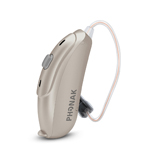 Receiver In the Canal (RIC)—This is the most popular style of hearing aid today, which is also sometimes called a Receiver In The Ear (RITE) or Over The Ear (OTE) device. It is effective in treating mild to moderately severe hearing loss. Its small casing rests behind the ear and houses the adjustment controls. This attaches to the receiver and microphone portion of the hearing aid, which rests in the ear canal, by a thin, clear electrical wire. These hearing aids are innovative because they only amplify sounds you struggle to hear while allowing sound frequencies you can hear normally in without amplification.
Receiver In the Canal (RIC)—This is the most popular style of hearing aid today, which is also sometimes called a Receiver In The Ear (RITE) or Over The Ear (OTE) device. It is effective in treating mild to moderately severe hearing loss. Its small casing rests behind the ear and houses the adjustment controls. This attaches to the receiver and microphone portion of the hearing aid, which rests in the ear canal, by a thin, clear electrical wire. These hearing aids are innovative because they only amplify sounds you struggle to hear while allowing sound frequencies you can hear normally in without amplification.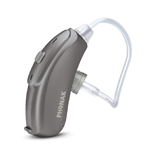 Behind The Ear (BTE)—These powerful devices are most commonly used for children, though many adults prefer them as well. They work to treat all types of hearing loss. Like the RIC hearing aid, BTE instruments have a casing housed behind the ear. In BTEs, however, the casing houses the receiver as well as the controls. The microphone reaches over the ear into the canal and is connected by a small tube.
Behind The Ear (BTE)—These powerful devices are most commonly used for children, though many adults prefer them as well. They work to treat all types of hearing loss. Like the RIC hearing aid, BTE instruments have a casing housed behind the ear. In BTEs, however, the casing houses the receiver as well as the controls. The microphone reaches over the ear into the canal and is connected by a small tube. Invisible In the Canal (IIC)—IIC models are customized wireless devices that are inserted deep within the ear canal, making them nearly undetectable when worn. Our patients can use IIC devices, which are the smallest hearing aid style available, for mild to moderate impairments. Because they’re placed so deeply within the ear, these devices provide excellent sound localization using less amplification. Due to their size, they offer few features.
Invisible In the Canal (IIC)—IIC models are customized wireless devices that are inserted deep within the ear canal, making them nearly undetectable when worn. Our patients can use IIC devices, which are the smallest hearing aid style available, for mild to moderate impairments. Because they’re placed so deeply within the ear, these devices provide excellent sound localization using less amplification. Due to their size, they offer few features.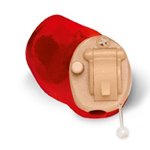 Completely In the Canal (CIC)—These devices are similar to but slightly larger than IIC models. The custom-made shell houses all of the devices’ components and controls and is only very slightly noticeable within the ear canal. CIC devices use just one microphone, but the sound is highly localized due to its location deep within the ear. They typically treat mild to moderate hearing loss, though they can sometimes be used for severe hearing loss.
Completely In the Canal (CIC)—These devices are similar to but slightly larger than IIC models. The custom-made shell houses all of the devices’ components and controls and is only very slightly noticeable within the ear canal. CIC devices use just one microphone, but the sound is highly localized due to its location deep within the ear. They typically treat mild to moderate hearing loss, though they can sometimes be used for severe hearing loss. In The Canal (ITC)—ITC customized hearing aids are once again similar to IIC and CIC devices, but they’re one size larger. They fit into the lower bowl of the ear and often contain two microphones for directional hearing enhancement as well as additional settings and features not available in smaller devices. These hearing aids are most commonly used for mild to moderate hearing loss, though they can sometimes treat more severe cases.
In The Canal (ITC)—ITC customized hearing aids are once again similar to IIC and CIC devices, but they’re one size larger. They fit into the lower bowl of the ear and often contain two microphones for directional hearing enhancement as well as additional settings and features not available in smaller devices. These hearing aids are most commonly used for mild to moderate hearing loss, though they can sometimes treat more severe cases.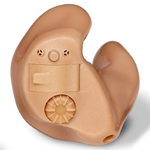 In The Ear (ITE)—This style of hearing aid is custom-made and fills the entire outer bowl of the ear. While these devices are noticeable to others, they offer many perks including a longer battery life, more features, improved ease of use and louder sound amplification. These factors make them useful for seniors and anyone with mild to severe hearing loss.
In The Ear (ITE)—This style of hearing aid is custom-made and fills the entire outer bowl of the ear. While these devices are noticeable to others, they offer many perks including a longer battery life, more features, improved ease of use and louder sound amplification. These factors make them useful for seniors and anyone with mild to severe hearing loss. Extended wear (Lyric)—Lyric devices are the latest in hearing aid technology. These devices are inserted deep within the ear canal and worn until their battery runs out. Batteries can last up to four months. Once the battery is gone, we’ll dispose of your Lyric device and insert new ones. Extended wear devices are excellent for active patients and can be used for mild to moderately severe hearing loss.
Extended wear (Lyric)—Lyric devices are the latest in hearing aid technology. These devices are inserted deep within the ear canal and worn until their battery runs out. Batteries can last up to four months. Once the battery is gone, we’ll dispose of your Lyric device and insert new ones. Extended wear devices are excellent for active patients and can be used for mild to moderately severe hearing loss.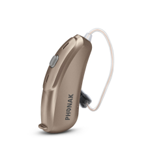 The CROS II from Phonak is the latest technology available for our patients with single-sided deafness. This device transmits sound from the ear with no hearing to the hearing aid you’re wearing in your other ear, allowing you to hear sounds coming from any direction.
The CROS II from Phonak is the latest technology available for our patients with single-sided deafness. This device transmits sound from the ear with no hearing to the hearing aid you’re wearing in your other ear, allowing you to hear sounds coming from any direction. - The CROS II incorporates Phonak’s StereoZoom directional microphone technology, which offers automatic background noise reduction and the ability to focus on one voice, even in a crowded and noisy setting. CROS II can automatically adjust its programming in any situation, though volume can still also be manually controlled. It’s compatible with all Phonak Venture hearing aids and can be customized to the color you choose. If you want to find our more about whether CROS II is right for you, please schedule an appointment so we can talk further about your hearing needs.


